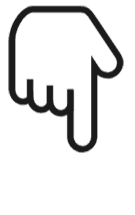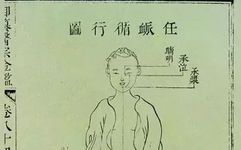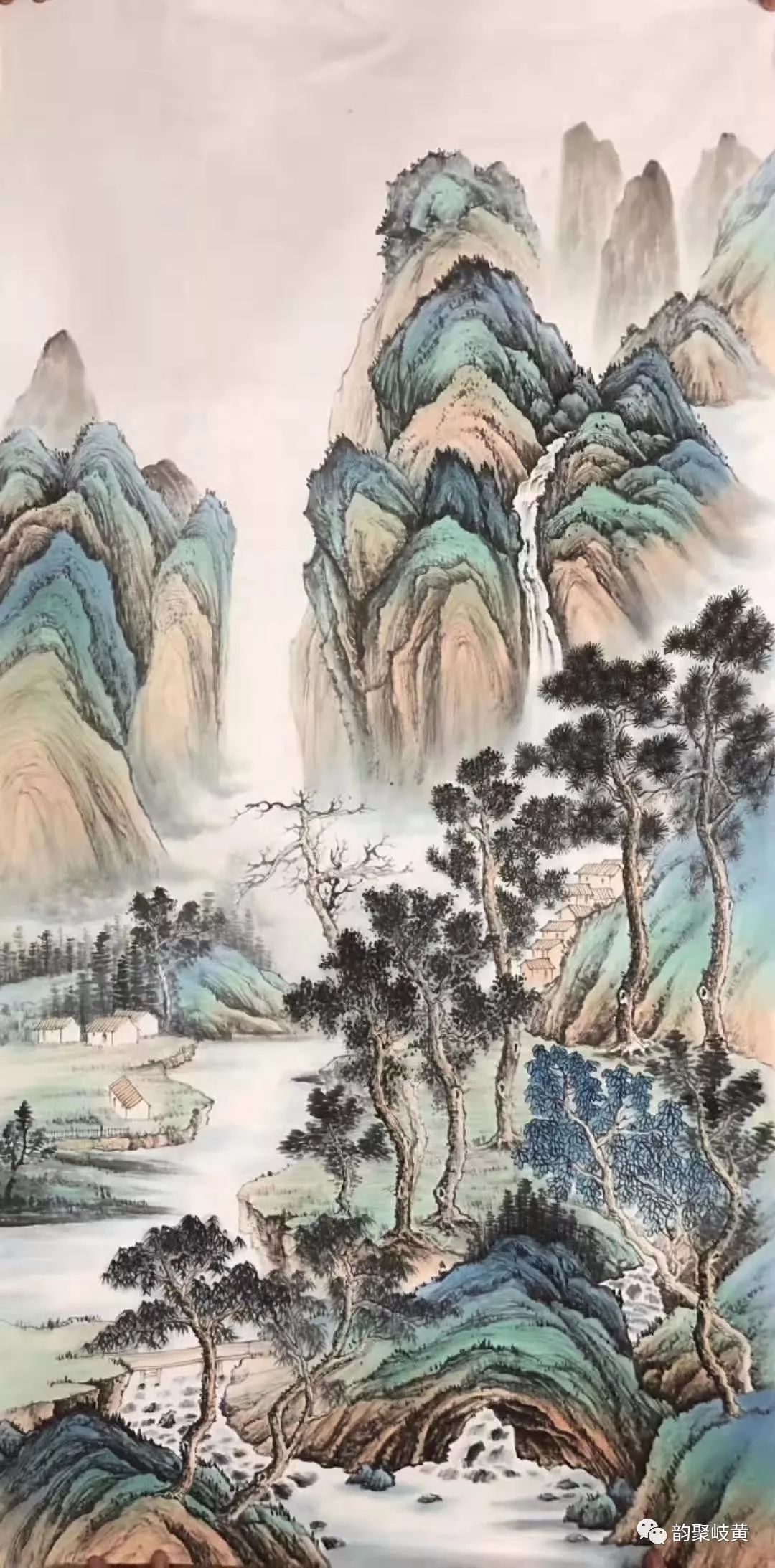
The Total Song of the Eight Extraordinary Meridians from the Medical Canon of the Golden Mirror
The regular meridians are external, while the extraordinary meridians are internal; the eight meridians each have their own names.
The Ren (任) meridian runs in front, while the Du (督) meridian runs in the back; the Chong (冲) meridian rises and connects with the perineum, traveling alongside the kidneys.
The Yang Qiao (阳跷) meridian is separate from the external bladder, while the Yin Qiao (阴跷) meridian follows the front and connects with the Shao Yin (少阴).
The Yang Wei (阳维) meridian connects all Yang meridians, while the Yin Wei (阴维) meridian connects all Yin meridians.
The Dai (带) meridian encircles the waist like a belt, and does not conform to the regular pathways, hence it is called extraordinary.
Note:
● There are regular and extraordinary meridians; the twelve meridians are regular, while the extraordinary meridians are not bound by the regular pathways, hence they are called extraordinary.
● The Qi and blood of a person regularly flow through the twelve meridians; when the meridians overflow, they flow into other meridians, hence they are named extraordinary.
● There are eight extraordinary meridians: Ren, Du, Chong, Dai, Yang Qiao, Yang Wei, Yin Wei.
● The Ren meridian runs in front, the Du meridian runs in the back, the Chong meridian is the sea of all meridians, the Dai meridian is like a belt around the body, the Yang Qiao is a branch of the foot Tai Yang (足太阳), and the Yin Qiao is a branch of the foot Shao Yin (足少阴); the Yang Wei connects all Yang meridians, and the Yin Wei connects all Yin meridians, balancing Yin and Yang, thus harmonizing all meridians.
● Therefore, these eight meridians are like channels designed to manage water flow, preventing overflow; the extraordinary meridians in a person function similarly.
—1—
Ren Meridian Pathway Text
According to the “Suwen: Theory of Bone and Hollow” (素问•骨空论): The Ren meridian originates below the Zhongji (中极) point, above the pubic hair line, running through the abdomen, ascending to the Guanyuan (关元) point, reaching the throat and jaw, and running through the face to the eyes (see Figure 74).
According to the “Ling Shu: Five Sounds and Five Tastes” (灵枢•五音五味篇): The Chong and Ren meridians both originate in the womb, ascending along the back as the sea of meridians; those that float outward run up the abdomen, meeting at the throat, branching to connect with the lips.
—2—
Ren Meridian Pathway Song
The Ren meridian starts below the Zhongji, runs through the perineum and abdomen to the Guanyuan, ascends internally to meet the Chong meridian, and floats outward to the throat, branching to connect with the lips and Chengjiang (承浆),
passing through the foot Yangming (足阳明) to the jaw, running through the face to the eyes until reaching the Qingming (睛明), intersecting with the Du meridian at the Yin meridian sea.
Note:
● The Ren meridian originates below the Zhongji.
● Zhongji is the name of an acupuncture point, located above the pubic area.
● Below the Zhongji refers to the perineum point below the pubic bone.
● Above the Zhongji, running through the abdomen to the Guanyuan refers to the pathway from the perineum ascending internally to meet the Chong meridian, which is the sea of meridians.
● Those that float outward run up the abdomen to the throat, branching to connect with the lips, ending at Chengjiang.
● The pathway from the jaw to the eyes refers to not directly intersecting with the Du meridian, but rather running from the foot Yangming Chengqi (承泣) point up to the jaw, entering the eyes at the foot Tai Yang Jingming (睛明) point, ultimately intersecting with the Du meridian, constituting the sea of Yin meridians.
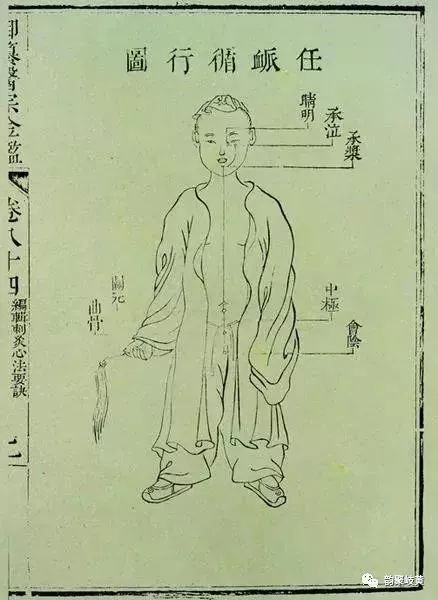
Ren Meridian Pathway Diagram
—3—
Ren Meridian Acupuncture Point Song
The Ren meridian has twenty-four points, starting from the perineum between the two Yin,
the Qugu (曲骨) is in front of the Zhongji,
the Guanyuan is at the Qi Hai (气海) beside the stone gate,
the Yin Jiao (阴交) is at the water point,
the Xiawan (下脘) is in front of the Zhongwan (中脘),
the Shangwan (上脘) connects to the Jueqi (巨阙),
the Middle Court (中庭) is at the center of the chest,
the Dan Zhong (膻中) is at the Yutang (玉堂),
the Zigong (紫宫) is at the Huagai (华盖),
the Tiantu (天突) is at the Lianquan (廉泉),
the Chengjiang is at the front of the lips.
—4—
Ren Meridian Measurement Song
The Ren meridian is between the two Yin at the perineum,
the Qugu is at the pubic hair line,
the Zhongji is four inches below the navel,
the Guanyuan is three inches below the navel,
the Shimen (石门) is two inches below the navel,
the Qi Hai is one and a half inches below the navel.
The Yin Jiao is one inch below the navel,
the Shenque (神阙) is at the center of the navel,
the Shui Fen (水分) is one inch above the navel,
the Xiawan is two inches above the navel,
the Jianli (建里) is three inches above the navel,
the Zhongwan is four inches above the navel,
the Shangwan is five inches above the navel,
the Jueqi is six inches above the navel,
the Jiuwei (鸠尾) is five inches below the coccyx,
the Middle Court is six inches below the chest,
the Dan Zhong is between the two breasts,
the Yutang is six inches above the Dan Zhong,
the Zigong is three inches above the Dan Zhong,
the Huagai is four inches above the Zigong,
(four inches and eight tenths)
the Xuanji (璇玑) is five inches above the Huagai,
the Tiantu is one inch above the Xuanji,
the Lianquan is four inches below the chin,
the Chengjiang is below the lips.
Note:
1. The perineum point is between the front and back Yin, where the Ren, Du, and Chong meridians originate; the Du runs from the perineum along the back, the Ren runs from the perineum along the abdomen, and the Chong runs from the perineum down to the feet.
2. Ascending from the perineum, the Qugu is at the pubic hair line.
3. Ascending from the Qugu, the Zhongji is four inches below the navel.
4. Ascending from the Zhongji, the Guanyuan is three inches below the navel.
5. Ascending from the Guanyuan, the Shimen is two inches below the navel.
6. Ascending from the Shimen, the Qi Hai is one and a half inches below the navel.
7. Ascending from the Qi Hai, the Yin Jiao is one inch below the navel.
8. Ascending from the Yin Jiao, the Shenque is at the center of the navel.
9. Ascending from the Shenque, the Shui Fen is one inch above the navel.
10. Ascending from the Shui Fen, the Xiawan is two inches above the navel.
11. Ascending from the Xiawan, the Jianli is three inches above the navel.
12. Ascending from the Jianli, the Zhongwan is four inches above the navel.
13. Ascending from the Zhongwan, the Shangwan is five inches above the navel.
14. Ascending from the Shangwan, the Jueqi is six inches above the navel.
15. Ascending from the Jueqi, the Jiuwei is five inches below the coccyx.
16. Ascending from the Jiuwei, the Middle Court is six inches below the chest.
17. Ascending from the Middle Court, the Dan Zhong is between the two breasts.
18. Ascending from the Dan Zhong, the Yutang is six inches above the Dan Zhong.
19. Ascending from the Yutang, the Zigong is three inches above the Yutang.
20. Ascending from the Zigong, the Huagai is four inches above the Zigong.
21. Ascending from the Huagai, the Xuanji is five inches above the Huagai.
22. Ascending from the Xuanji, the Tiantu is one inch above the Xuanji.
23. Ascending from the Tiantu, the Lianquan is four inches below the chin.
24. Ascending from the Lianquan, the Chengjiang is below the lips.
—5—
Du Meridian Pathway Text
According to the “Suwen: Theory of Bone and Hollow” (素问•骨空论): The Du meridian originates from the center of the bone below the lower abdomen; for women, it connects to the vaginal opening, which is the end of the urinary opening. It connects to the Yin organs, encircling the lower back, branching to the buttocks, and connecting to the Shao Yin and Yangming meridians, running along the inner thigh to the kidney, connecting to the eyes, ascending to the forehead, crossing the vertex, entering the brain, and exiting below the neck, running along the shoulder and back, reaching the waist, entering the spine, and connecting to the kidneys.
For men, it runs along the penis down to the urinary opening, similar to women.
It ascends directly from the lower abdomen, passing through the navel, entering the throat and jaw, encircling the lips, and connecting to the center below the eyes.
—6—
Du Meridian Pathway Song
The Du meridian runs through the center of the lower abdomen,
for women, it connects to the urinary opening,
for men, it runs along the penis,
branching to the buttocks,
it connects to the Shao Yin, ascending through the abdomen to the Guanyuan,
connecting to the kidneys and the Chong meridian,
entering the throat and jaw, encircling the lips,
and connecting to the center below the eyes,
it begins at the inner canthus and connects to the Tai Yang,
ascending to the forehead, entering the brain,
exiting below the neck, running along the shoulder and back,
reaching the waist, entering the spine,
and connecting to the kidneys,
this is the pathway of the Du meridian,
which governs all Yang meridians.
Note:
● The Du meridian originates from the center of the bone below the lower abdomen, referring to both men and women below the lower abdomen, at the center of the pubic bone, which is the end of the vaginal opening for women and the urinary opening for men.
● The connection to the Yin organs encircles the lower back, branching to the buttocks, and connects to the Shao Yin in the inner thigh, running along the abdomen to the kidneys, connecting to the Chong meridian.
● The pathway ascends directly from the lower abdomen, passing through the navel, entering the throat and jaw, encircling the lips, and connecting to the center below the eyes.
● The pathway from the inner canthus connects to the Tai Yang, ascending to the forehead, entering the brain, exiting below the neck, running along the shoulder and back, reaching the waist, entering the spine, and connecting to the kidneys, thus completing the pathway of the Du meridian.
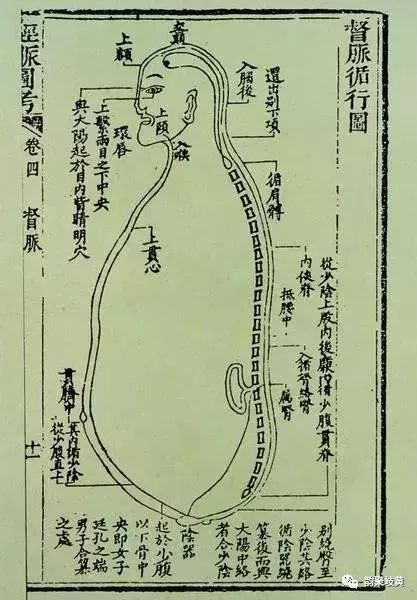
Du Meridian Pathway Diagram
—7—
Du Meridian Acupuncture Point Song
The Du meridian has twenty-eight points, starting from the Changqiang (长强),
the Yaoyang (腰俞) connects to the Mingmen (命门),
the Xuan Shu (悬枢) is at the center of the spine,
the Dazhui (大椎) connects to the Yamen (哑门),
the Naohui (脑户) is at the back of the head,
the Baihui (百会) is at the top of the head,
the Shangxing (上星) is at the Shen Ting (神庭),
the Shuai (水沟) is at the upper lip,
the Yinjiao (龈交) is at the upper teeth.
—8—
Du Meridian Measurement Song
The Changqiang is at the end of the coccyx,
the Yaoyang is at the lumbar spine,
the Yangguan (阳关) is at the fourteenth vertebra,
the Xuan Shu is at the center of the spine,
the Dazhui is at the tenth vertebra,
the Yaoyang is at the ninth vertebra,
the Ling (灵) is at the fifth vertebra,
the Shen (身) is at the third vertebra,
the Tao (陶) is at the second vertebra,
the Dazhui is at the first vertebra,
the Fengfu (风府) is at the back of the head,
the Naohui is at the back of the head,
the Baihui is at the top of the head,
the Yinjiao is at the upper lip,
the Chengjiang is at the lower lip.
Note:
1. The Du meridian starts at the Changqiang, which is the end of the coccyx, and runs along the spine.
2. The pathway runs along the back, connecting to the Yang meridians, entering the spine.
3. The pathway ascends to the Fengfu, entering the brain, and exits at the Baihui, which is the top of the head.
4. The pathway runs along the back, connecting to the Yinjiao, which is at the upper lip.
5. The pathway runs along the upper teeth, connecting to the Chengjiang, which is at the lower lip.
6. The Du meridian has twenty-eight points, running along the back.
—9—
Chong Meridian Pathway Text
According to the “Suwen: Theory of Bone and Hollow” (素问•骨空论): The Chong meridian originates from the Qi Street, connecting to the Shao Yin meridian, ascending through the navel, and dispersing in the chest.
According to the “Ling Shu: Wei Qi” (灵枢•卫气篇): The Qi Street is the pathway of Qi; the chest has a Qi Street, the abdomen has a Qi Street, and the leg has a Qi Street.
Thus, Qi in the head stops at the brain; Qi in the chest stops at the chest and back; Qi in the abdomen stops at the back. The Chong meridian moves to the left and right of the navel, where the Qi is in the leg, stopping at the Qi Street, connecting to the Chengshan (承山) and the ankle.
—10—
Chong Meridian Pathway Song
The Chong meridian originates from the abdominal Qi Street,
the postnatal Qi flows into the chest,
combining with the prenatal true Qi,
ascending through the navel to the chest,
the great Qi disperses in the chest,
distributing to the organs and meridians,
this is called the sea, not to be confused.
Note:
● The Chong meridian originates from the Qi Street, which is the abdominal Qi pathway.
● The term Qi Street refers to the pathway of Qi.
● The great Qi accumulates in the chest, which includes both prenatal true Qi and postnatal Qi, which is transformed from food and water.
● This is called the sea of the five organs and six bowels, as they all receive Qi.
● The Chong meridian is the sea of the twelve meridians, connecting to the Shao Yin meridian, originating from below the kidneys, and exiting from the Qi Street.
—11—
Chong Meridian Acupuncture Point Song
The Chong meridian runs horizontally from the navel,
the great Qi flows into the chest,
the Shangshi (商石) connects to the Youmen (幽门) point,
and disperses in the chest, flowing through the Ren meridian.
—12—
Chong Meridian Measurement Song
Text: The Chong meridian measurement is the same as the Shao Yin,
originating from the horizontal bone to the Youmen,
ascending through each point by one inch,
each point along the pathway is five tenths.
Note:
The Ren, Du, and Chong meridians, according to the “Suwen: Theory of Bone and Hollow” (素问•骨空论): The Ren meridian originates below the Zhongji, above the pubic hair line.
This refers to the external aspect of the lower abdomen. The internal aspect refers to the womb. The Du meridian originates from the center of the bone below the lower abdomen, connecting to the vaginal opening for women and the urinary opening for men, which also refers to the external aspect of the lower abdomen, while the internal aspect refers to the womb.
The Chong meridian originates from the Qi Street, connecting to the Shao Yin meridian, which also refers to the womb; although it does not explicitly mention the womb, it has never been said to not originate from the womb. Thus, it is clear that the Ren, Du, and Chong meridians all originate from the womb.
Therefore, all three meridians are transformed from the postnatal food and water, with the stomach Qi emerging from the Qi Street, connecting to the womb, and combining with the prenatal true Qi, thus filling the body.
From this perspective, it is evident that the three meridians share a common source.
Thus, Wang Bing’s annotations in the “Neijing”, “Jia Yi Jing”, and “Zhen Jiu Tu Jing” refer to the Ren meridian running along the back as the Du meridian; from the lower abdomen, it is referred to as the Ren meridian, also called the Du meridian, distinguishing between the Yin and Yang of the back and front.
However, the Chong meridian also originates from the womb, ascending along the Shao Yin meridian. Therefore, the Ren, Du, and Chong meridians are three branches from a single source.
Thus, the human body has both front and back, just as the universe has the yin and yang; the Ren and Du meridians have front and back, just as the two lands are divided into yin and yang.
The womb refers to the common term for the lower abdomen in both men and women; in women, it is called the uterus, while in men, it is the seminal chamber.
Note:
● The Chong meridian originates from the foot Yangming, connecting to the foot Shao Yin at the Qi Street, running through the navel, and ascending through the horizontal bone, from the horizontal bone to the Dahu (大赫), Qi (气), Siman (四满), Zhongzhu (中注), Huangyu (肓俞), Shangqu (商曲), Shiguan (石关), Yindu (阴都), Tonggu (通谷), Youmen (幽门), totaling eleven points, each point ascending by one inch, and each point along the pathway is five tenths.
—13—
Dai Meridian Pathway Text
According to the “Ling Shu: Meridian Branches” (灵枢•经脉别篇): The foot Shao Yin meridian ascends to the knee, branching to the Yang meridian and connecting to the kidneys at the fourteenth vertebra, exiting to the Dai meridian.
According to the “Twenty-Eight Difficulties” (二十八难): The Dai meridian originates from the lateral costal region, encircling the body.
—14—
Dai Meridian Pathway Song
The Dai meridian is from the foot Shao Yin,
ascending to the knee, branching to the Yang meridian,
connecting to the kidneys at the fourteenth vertebra,
originating from the lateral costal region, encircling the body.
Note:
● The Dai meridian originates from the foot Shao Yin meridian, ascending to the knee, branching to the Yang meridian, connecting to the kidneys at the fourteenth vertebra, thus encircling the body.
—15—
Dai Meridian Acupuncture Point Song
The Dai meridian originates from the Shao Yang,
encircling the five pivots between the meridians,
the Jingmen (京门) is below the Liao (髎),
encircling the lateral costal region.
Note:
● The foot Shao Yin meridian originates from the Rangu (然谷), running along the inner ankle; its branch enters the heel, ascending to the knee, branching to the Yang meridian, connecting to the kidney Qi at the fourteenth vertebra, and exiting to the Dai meridian, thus originating from the lateral costal region, encircling the body.
● Therefore, the “Twenty-Eight Difficulties” states: The Dai meridian originates from the lateral costal region, encircling the body.
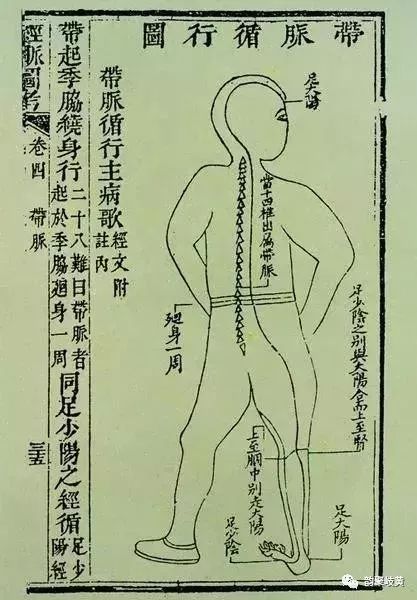
Dai Meridian Pathway Diagram
—16—
Dai Meridian Measurement Song
The Dai meridian is part of the foot Shao Yang,
the lateral costal region is its origin,
the Dai is three inches from the five pivots,
passing through the Zhang (章) five inches to the Wei Dao (维道).
Note:
● The Dai meridian is part of the foot Shao Yang meridian, located one inch and eight tenths below the lateral costal region, which is the Dai meridian point.
● From the Dai meridian point, three inches down is the five pivots point.
● From the five pivots, five inches down is the Wei Dao point.
—17—
Yang Qiao and Yin Qiao Meridian Pathway Text
According to the “Ling Shu: Meridian Measurement” (灵枢·脉度篇): The Qiao meridian is a branch of the Shao Yang, originating from the Rangu (然谷), ascending above the outer ankle, directly ascending along the inner thigh, entering the Yin, ascending through the chest, entering the diaphragm, exiting in front of the Renying (人迎), entering the jaw, connecting to the inner canthus, and merging with the Tai Yang and Yang Qiao, ascending; if the Qi is not sufficient, the eyes will not be nourished, thus the eyes cannot close.
According to the “Twenty-Eight Difficulties” (二十八难): The Yang Qiao meridian originates from the center of the heel, ascending along the outer ankle, entering the Fengchi (风池); the Yin Qiao meridian also originates from the center of the heel, ascending along the inner ankle, reaching the throat and connecting to the Chong meridian.
—18—
Yang Qiao Meridian Pathway Song
The Yang Qiao meridian originates from the center of the heel,
ascending to connect with the three Yang meridians,
running from the side to the shoulder, entering the neck and jaw,
connecting to the inner canthus of the eyes,
and merging with the Tai Yang meridian.
Note:
● The Yang Qiao meridian originates from the center of the heel, ascending to connect with the three Yang meridians, running from the side to the shoulder, entering the neck and jaw, connecting to the inner canthus of the eyes, merging with the Tai Yang meridian.

—19—
Yang Qiao Meridian Song
The Yang Qiao meridian originates from the foot Tai Yang,
the Shenmai (申脉) is five tenths below the outer ankle,
the Pucan (仆参) is behind the heel,
the Fuyin (附阳) is three inches from the outer ankle,
the Jujiao (居髎) is above the shoulder blade,
the Jian (肩) is at the shoulder,
the Jugu (巨骨) is at the shoulder blade,
the Dica (地仓) is beside the mouth,
the Jiu (巨髎) is eight tenths beside the nose,
the Chengqi (承泣) is seven tenths below the eyes,
the Jingming (睛明) is at the inner canthus of the eyes.
Note:
1. The Qiao refers to the foot; the extraordinary meridians that involve the foot are named as such.
2. The term Yang refers to the meridian’s association with Yang meridians.
3. The Yang Qiao is a branch of the foot Tai Yang meridian, originating from the foot Tai Yang bladder meridian, five tenths below the outer ankle at the Shenmai point.
4. It runs from the Shenmai point around the heel to the Pucan point.
5. From the Pucan point, it ascends three inches to the Fuyin point.
6. It connects with the foot Shao Yang at the lateral costal region, at the Jujiao point.
7. It connects with the hand Yangming at the shoulder, at the Jian point.
8. It ascends to the Jugu point at the shoulder blade.
9. It connects with the hand and foot Tai Yang at the Dica point beside the mouth.
10. It connects with the hand and foot Yangming at the Jiu point beside the nose.
11. It connects with the hand and foot Tai Yang at the Chengqi point below the eyes.
12. It connects with the hand and foot Tai Yang at the Jingming point at the inner canthus of the eyes.
—20—
Yin Qiao Meridian Acupuncture Point Song
The Yin Qiao originates from the Rangu point,
ascending to the Zhaohai (照海) point,
three points originally from the foot Shao Yin,
connecting to the foot Tai Yang at the Jingming point.
—21—
Yin Qiao Meridian Measurement Song
Text: The Yin Qiao meridian originates from the foot Shao Yin,
ascending from the inner ankle to the Rangu point,
one inch below the ankle is the Zhaohai point,
two inches above the ankle is the Jiaoxin (交信) point,
the inner canthus is at the Jingming point,
the eyes are at the inner canthus.
Note:
● The Yin Qiao refers to the meridian that runs along the Yin meridians, being a branch of the foot Shao Yin meridian.
● It originates from the foot Shao Yin kidney meridian, at the Rangu point, which is located below the inner ankle.
● From the Rangu point, it ascends one inch below the ankle to the Zhaohai point.
● From the Zhaohai point, it ascends two inches above the ankle to the Jiaoxin point.
● From the Jiaoxin point, it ascends to the chest, entering the throat, connecting to the Ren meridian.
● The Yin Qiao meridian connects to the inner canthus, merging with the Tai Yang, ascending; if the Qi is not sufficient, the eyes will not be nourished, thus the eyes cannot close.
—22—
Yang Wei and Yin Wei Meridian Pathway Text
According to the “Twenty-Eight Difficulties” (二十八难): The Yang Wei and Yin Wei meridians are the connections in the body, overflowing and unable to circulate, nourishing the various meridians.
Thus, the Yang Wei originates from the convergence of all Yang meridians, while the Yin Wei originates from the convergence of all Yin meridians.
—25—
Yang Wei Meridian Pathway Song
The Yang Wei originates from the foot Tai Yang,
below the outer ankle at the Jinmen (金门) point,
running along the back of the shoulder and neck,
connecting to all Yang meridians at the Du meridian.
Note:
● The Yang Wei meridian originates from the convergence of all Yang meridians, starting from the Jinmen point below the outer ankle.
—24—
Yang Wei Meridian Acupuncture Point Song
The Yang Wei meridian starts at the Jinmen point,
the Nao Yu (臑俞) is at the Tianjian (天肩井),
the Ben Shen (本神) is at the Linqi (临泣),
the Zheng Ying (正营) is at the Naohui (脑空),
the Fengfu (风府) is at the Yaomen (哑门),
the back of the neck is its root.
—25—
Yang Wei Meridian Measurement Song
The Yang Wei meridian originates from the foot Tai Yang,
one inch below the outer ankle is the Jinmen point,
seven inches above the ankle is the Yang Jiao (阳交) point,
the shoulder blade is at the Nao Yu point,
the Tianjian is at the shoulder,
the Ben Shen is at the top of the head,
the Fengfu is at the back of the head,
the Yaomen is at the back of the neck.
Note:
1. The Yang Wei originates from the convergence of all Yang meridians, starting from the Jinmen point below the outer ankle.
2. It runs along the back of the shoulder and neck, connecting to all Yang meridians at the Du meridian.
3. The Yang Wei meridian is responsible for nourishing the Yang meridians.
—26—
Yin Wei Meridian Pathway Text
According to the “Twenty-Eight Difficulties” (二十八难): The Yin Wei meridian originates from the foot Shao Yin,
ascending from the inner ankle to the Zhuxin (筑宾) point,
running through the abdomen to the chest,
connecting to the Ren meridian.
Note:
● The Yin Wei meridian originates from the foot Shao Yin kidney meridian, ascending from the inner ankle to the Zhuxin point, running through the abdomen to the chest, connecting to the Ren meridian.
—27—
Yin Wei Meridian Acupuncture Point Song
The Yin Wei meridian originates from the Zhuxin point,
the Fushi (府舍) is at the Dahu (大横),
the Qimen (期门) is at the Tiantu (天突),
the Tian Tuo (天突) is at the base of the tongue,
this is the Yin Wei meridian nourishing the Yin.

Yin Wei Meridian Pathway Diagram
—28—
Yin Wei Meridian Measurement Song
The Yin Wei meridian originates from the foot Shao Yin,
ascending from the inner ankle to the Zhuxin point,
below the lower abdomen is the Fushi point,
the Dahu is level with the navel,
this point is three and a half inches from the center,
the Qimen is two inches below the breast,
the Tian Tuo is one inch below the throat.
Note:
● The Yin Wei meridian originates from the convergence of all Yin meridians, starting from the Zhuxin point, ascending from the inner ankle, running through the abdomen to the chest, connecting to the Ren meridian.
========== END ==========
Warm Reminder:All formulas and treatments mentioned in this article are for learning reference only; non-professionals should not attempt to use them!This platform does not bear any responsibility for any consequences arising from this!
⊙ Copyright Statement: The article is sourced from the internet; if there is any infringement, please contact us for removal.
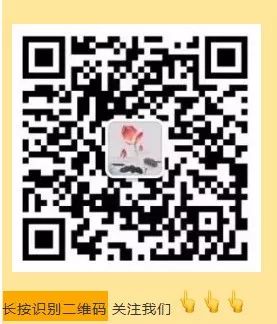

Reading is a form of wisdom, sharing is a virtue, forwarding is a motivation.
 If you like it, give it alook
If you like it, give it alook 